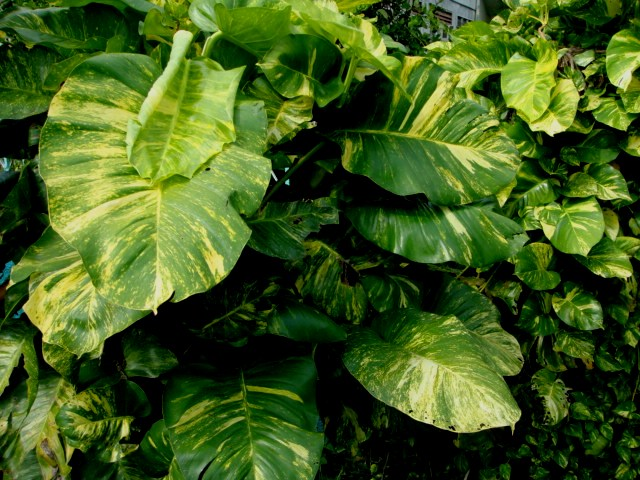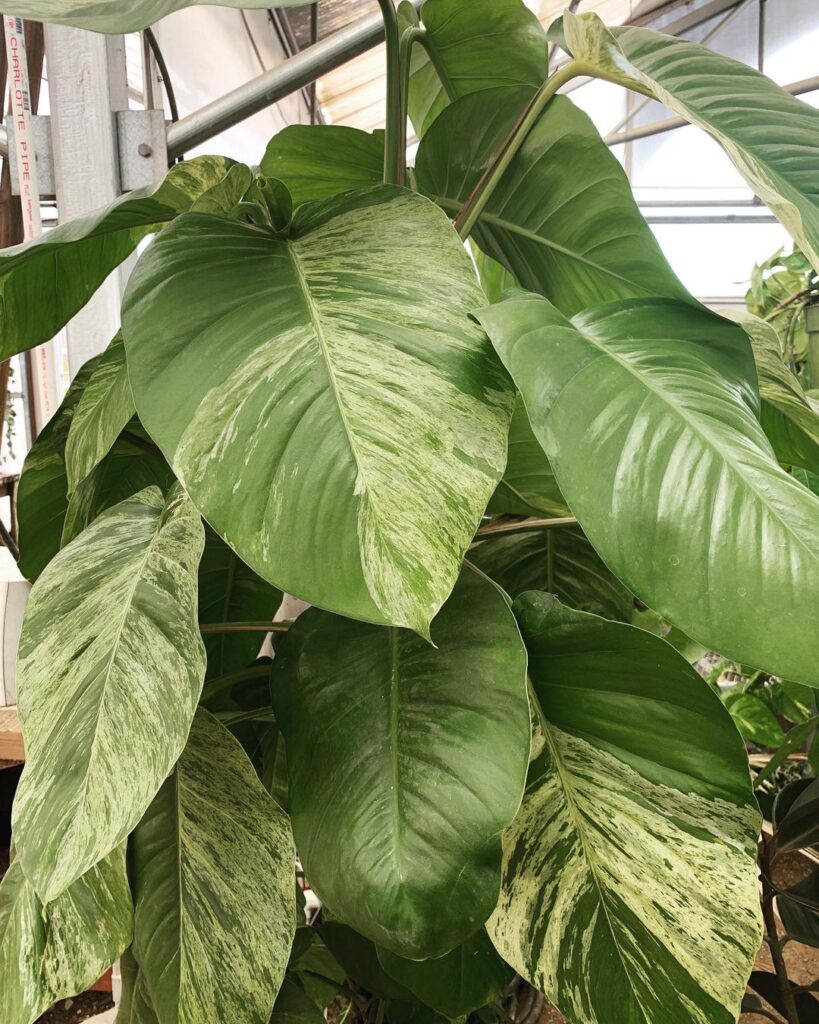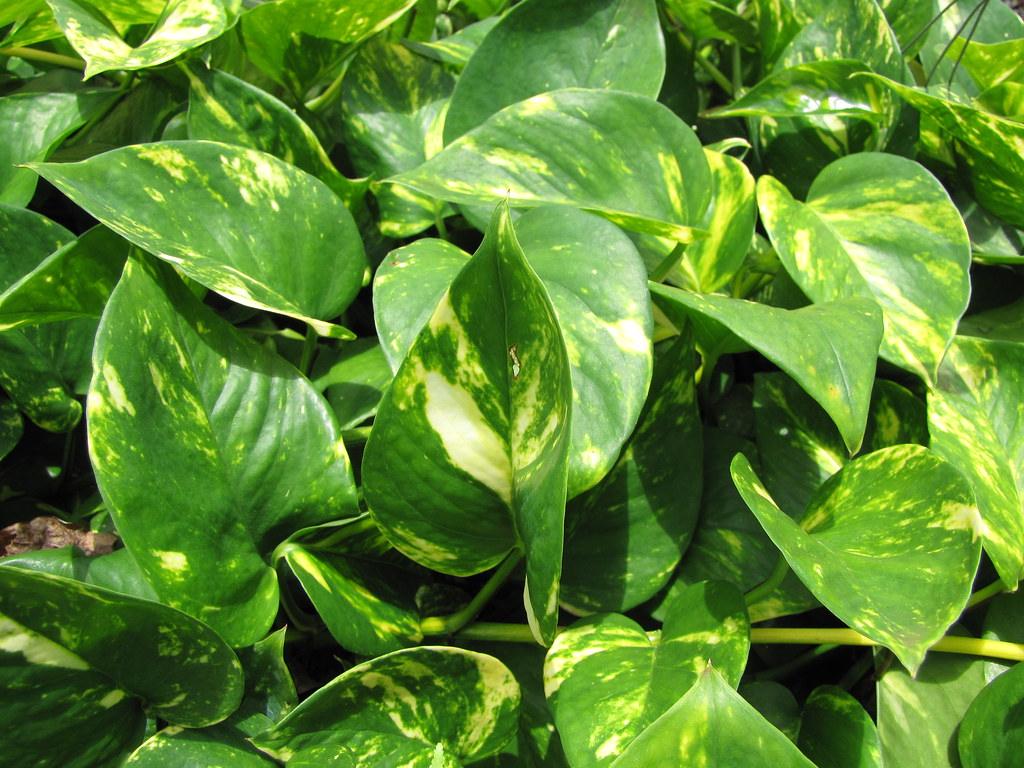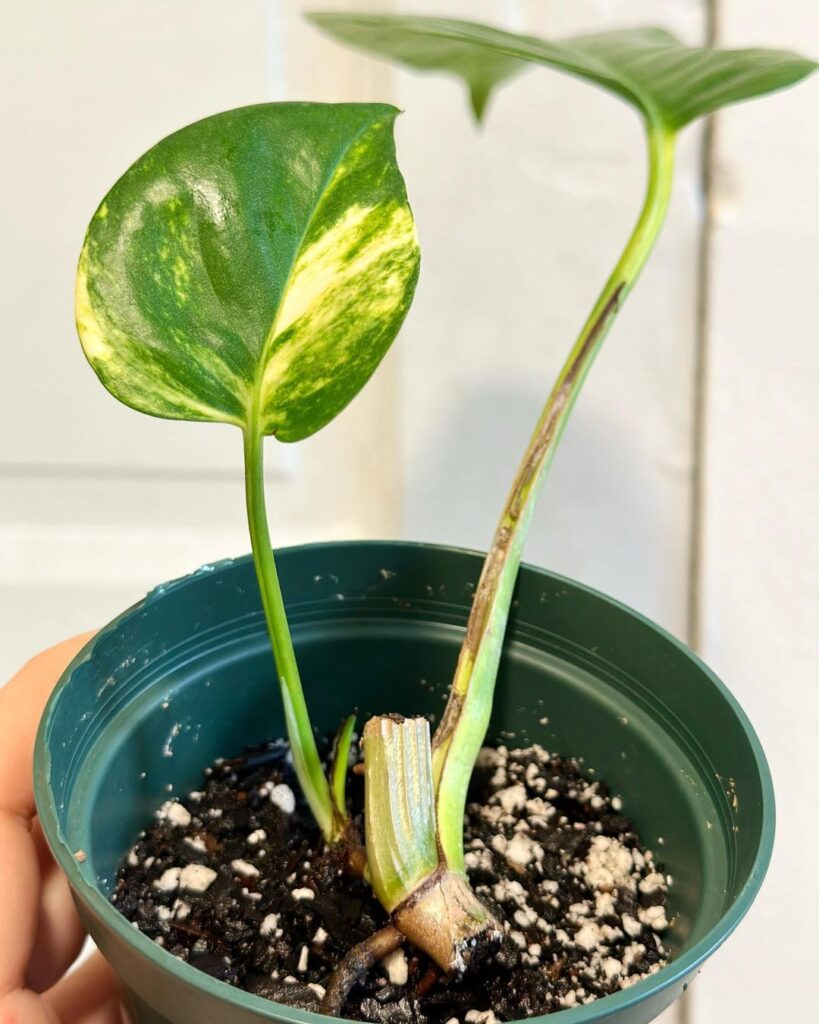Pothos plants are one of the easiest houseplants to grow. Given that it requires little maintenance, it makes a great indoor plant. There are numerous varieties of pothos, including the Hawaiian and Golden Pothos. These plants flourish in a range of habitats, but they are commonly confused with one another. In this article, find out about Golden pothos vs Hawaiian pothos.


The leaves are the primary distinction between the Hawaiian Pothos and Golden Pothos. The leaves of the Hawaiian Pothos are green and pale yellow. Golden Pothos, however, has a considerably brighter and more vivid golden hue.
The leaves on Hawaiian Pothos are also bigger than those on Golden Pothos. While Golden Pothos may thrive in a less bright environment, Hawaiian Pothos prefers a position with brighter indirect sunshine.
Keep on reading to know more about the differences and similarities between the two endearing pothos.
General Information
Golden Pothos

The Golden Pothos is a kind of pothos plant that is easy to cultivate and maintain. The rich green, which turns to yellow, heart-shaped leaves of the golden pothos are what makes this plant so well-liked.
Arguably, the Golden Pothos is the best tropical plant for beginners since it requires the least effort to grow and care for indoors. Pothos need both damp and dry soil, high level of humidity, and strong indirect light to grow.
The tiny snow-white blossoms and restricted growth of this perennial plant make it ideal for an interior setting. The yellow vines may be paired with any home décor.
On the other hand, the leaves feature fenestrations, and the whole plant often change color along with the growth season. It can grow to be up to 3-6 feet broad and 20-30 feet long.
Hawaiian Pothos

The Hawaiian Pothos plant species of pothos is ideal for hanging baskets because of its large leaves. A lasting impression is made by the leaf hue, which has pale yellow streaks embedded on the deep green foliage.
The lengthy, trailing tendrils and large leaves form an attractive vertical accent. Pruning the green leaves aids in maintaining a compact form and controlling stem length.
Large cream-white blooms are produced by Hawaiian pothos, which, unlike other varieties, do not develop leaf fenestration.
Hawaiian pothos is more expensive than other varieties. The medium to brilliant indirect light, high relative humidity, and slightly damp soil are preferred by giant Hawaiian pothos.
RELATED: Droopy Pothos? No Problem! How to Save Your Drooping Plant
Differences Between Golden Pothos & Hawaiian Pothos
It’s difficult to tell the difference between these similarly-looking two pothos types, but the main difference between them is their appearance.
Stem And Leaf Color
Golden Pothos
Its name is derived from the golden variegation on some of its flecks. The leaves of Golden Pothos are a brighter yellow with white and dark green streaks.
The pattern varies from leaf to leaf; some have green patches and gold specks, while others have so much yellow variegation that they nearly seem to shine. Golden pothos usually has yellow vines.
Hawaiian Pothos
The pattern and color of Hawaiian pothos are comparable to golden pothos. At first glance, they appear to be the same plant. However, the Hawaiian pothos has a pale yellow, almost creamy tint, and dark green and yellow variegation.
Unlike other plants, it doesn’t change color. The color stays, but the intensity of the green changes with the amount of sunshine received by the plant. Furthermore, Hawaiian pothos develops green stems if given the proper living conditions.
Size And Shape
Golden Pothos
Both Hawaiian and Golden Pothos are plants that grow on vines. These plants can grow up to 30 feet tall in the wild.
However, golden pothos stays relatively small indoors. It typically has a growth range of 6 to 10 feet.
Furthermore, when they mature, plants like Monstera and Golden Pothos have fenestrations, or split leaves. This type of fenestration will not be found on Hawaiian Pothos.
Hawaiian Pothos
The leaf forms of the two plants are pretty much identical. The only difference is that Hawaiian Pothos leaves are slightly more rounded at the tips than Golden Pothos leaves.
Under the same circumstances, Hawaiian pothos leaves grow substantially larger, depending on the lighting.
Due to their size and larger leaves that absorb more sunlight, Hawaiian pothos plants typically have greater overall sizes and develop relatively more quickly.
Flowers
Both plants need a lot of room to have a robust root system and a substantial crown before they can begin to bloom. The soil must also be well-drained, light, and nutrient-rich. It also requires a plenty of water and sunshine.
It is uncommon to see these plants blossom inside since, as you can imagine, it is challenging to create these circumstances. Only those who are fortunate enough to have pothos grow outside are able to get them to blossom.
Hawaiian Pothos is a bit larger plant, so its blooms are bigger. Additionally, rather than being white, its blossoms are cream in hue.
Snow-white blossoms with no touch of cream may be seen on Golden Pothos. Due to the reduced size of the plant itself, the blooms are also somewhat smaller than those of the rival. The smaller plant, however, has an advantage since it requires less soil and sunlight to flower.
Vines
Yellow vines grow on all Golden Pothos plants if they get adequate light. On the other hand, when all the requirements for growth are satisfied, Hawaiian Pothos often sprouts green stems.
Fenestrations
Perhaps you’re unclear about what fenestration is. Plants like Monstera and Golden Pothos, which originate from thick tropical forests, produce leaves that split to allow light or sun flecks to get to the bottom leaves.
Because of this, when they get older and move through the jungle, their original environment, their leaves break with age, enabling rain and sunshine to reach plants’ roots.
Your Golden Pothos may not commonly experience this. However, if the circumstances are right, you could be lucky to observe one.
Similarities Between Golden And Hawaiian Pothos
Taxonomy
The scientific name of the Pothos family, of which Hawaiian and Golden Pothos are cultivars, is Epipremnum aureum.
The Golden Pothos is named after the specific epithet aureum, which refers to the golden flecks in the leaves. The complete scientific name of the cultivar Golden Pothos is Epipremnum aureum ‘Golden.”
On the other hand, Epipremnum aureum “Hawaiian,” the botanical name for Hawaiian Pothos, a cultivar of this same species, indicates how closely related they are. These two plants are also called Devil’s Ivy, with only a few minor differences.
Sheath
Pothos does not have sheaths like Philodendron. These sheaths are known as cataphylls. Although they can also photosynthesize, they also protect the plant as it develops. This trait does not occur in both plants, as the leaves bud and unfold without any additional protection.
Native Habitat
Pothos species are native to tropical forests where the weather is warm, and the humidity is high. Both plants are vine-like and can reach heights of up to 30–50 feet in their natural environment, where they can trail on higher tree trunks. As indoor plants, they can be trained easily to grow on trellises or moss poles.
Growth Pattern
Like other pothos, golden and Hawaiian are vining plants with trailing growth patterns. It normally grows between 6 and 10 feet tall. But in their native environment, pothos may grow to heights of 30 up to 50 feet.
Massive pothos may trail on higher tree trunks in the forest, where they can be seen.
Structure And Height
Hawaiian and Golden Pothos leaves alternate, and as they spiral upward, just one leaf grows from each node. Pothos has simple leaves with blade lengths ranging from 4 to 8 inches to 12 to 18 and 18 to 36 inches.
The Pothos’ support determines its height. It trails to the summit for a greater distance the longer the building. If the leaves can grow, pothos spreads continuously and grows swiftly; for this reason, it is crucial to have the proper height structure.
RELATED: Pothos Leaves Curling, its Causes and Easy Ways to Fix Leaf Curl
Care Tips
Light Requirement
The optimal conditions for pothos are shade and just enough light. However, Hawaiian pothos requires medium-to-high light to sustain variegation and increase leaf growth. Bright, indirect light is the ideal condition for them to flourish and reach their greatest potential.
However, keep it out of direct sunlight to protect its foliage, because any strong midday or afternoon sun will have a bad effect and scorch the leaves of your plants. On the other hand, the leaves might not grow to their maximum size in dim lighting.
Temperature Requirement
Hawaiian Pothos and Golden Pothos have similar temperature requirements because they both originated in tropical forest environments.
They both require warm indoor temperatures, with the optimum temperature for growing pothos being between 65 degrees Fahrenheit and 85 degrees Fahrenheit (18°C and 29°C).
These plants can withstand higher temperatures than ordinary houseplants, but they cannot resist low temperatures. If the temperature falls below 55 °F (12 °C), pothos growth will be significantly slowed, and furthermore, the leaves may change color or suffer cold damage.
Water Requirement
The best advice when watering these plants is to check the top two inches of soil with your finger to determine if it is already dry before watering. Depending on its condition, the Hawaiian Pothos may require somewhat more water than the Golden Pothos.
Allowing the topsoil to dry up before watering minimizes root rot; make sure your container has good drainage. However, too much dryness is bad for pothos, causing the leaves to droop or turn brown.
Humidity Requirement
In their natural environment in tropical forests, humidity can range from 70–90% seasonally. As a result, the higher the humidity level, the better, because these plants prefer as much moisture in the air as they can obtain.
However, either plant can be kept in a space with a humidity level of at least 40% or higher. To ensure the right humidity, place a pebble tray or humidifier near these plants.
Soil Requirement
Pothos is known for being easy to take care of in terms of its potting mix since it grows in a variety of soil conditions. Just make sure the soil has a good capacity for drainage. Additionally, the planting containers must have ample drainage holes.
To increase the plant’s drainage, you can also make your own mix by mixing two parts of potting soil along with one part each of perlite and coconut coir.
Fertilizer Requirement
Pothos do not require much fertilizer, but they do benefit from it. Fertilize your plant during the spring and summer seasons. To make sure the potting soil has enough nutrients, use a balanced indoor plant fertilizer.
However, since pothos isn’t a heavy feeder, you don’t need to use a hefty fertilizer. The plant may get soft, the roots may be harmed, and the leaves may turn brown if you use more fertilizer than is advised.
Space Requirement
You can plant these two pothos plants in a regular pot or a hanging basket. You can use a conventional pot with a moss pole to help it flourish. If you like the concept of trailing leaves from the basket, hanging them from the ceiling could be a good option.
Growing And Planting Tips
Propagation
Propagating golden pothos and hawaiian pothos are simple. They can be multiplied by cutting and can be grown in either water or soil.
- Pick a good, healthy vine between four and six inches long and with three leaves.
- Next, cut the stem just above the node of the root.
- Fill one water bottle halfway with water to propagate it in water.
- Wait until the roots emerge after placing and submerging the cutting.
- If you aim to propagate it using soil, place vine cuttings inside a pot filled with good potting soil.
Potting And Repotting
Pothos must be transplanted once the roots have become pot-bound and have spread throughout the soil. When roots pop out of the drainage holes in the pot, it’s a sign that it’s time to repot.
If you decide to repot your plant, be careful not to harm any of the roots. The new pot should be 1-2 inches larger than the old one. Make sure the container has drainage holes, and the potting soil should be light and easily drained.
Problem And Troubleshooting
Given that both plants are cultivars of the same species, it is not surprising that they have the same issues.
- Overwatering is the most common issue with these plants, which can cause root rot and leaf yellowing. Therefore, make sure to have a proper watering schedule and try to check the top of the soil to see if it is already dry before watering again.
- On the other hand, underwatering can cause browning and the wilting of leaves. As a result, evaluate the soil and make adjustments as necessary.
- The browning or blackening of leaf tips can also be brought on by low temperatures and high humidity. Therefore, take care of these two plants according to the advice provided.
- Direct sunlight can cause brown spots.
Uses Of Golden Pothos And Hawaiian Pothos
The Golden Pothos is among the ideal indoor plants in terms of interior design since it can easily fit on shelves, a desk corner, or a windowsill. The plant’s distinctive golden sparkles brighten any space and go well with a bright, sunny day.
Hawaiian Pothos need a little bit more room due to their greater size. They make excellent standing plants for filling corners when they are trained around a moss pole in a big container. Their enormous leaves give any place a tropical vibe while being excellent air purifiers.
RELATED: Why Are The Leaves Turning Yellow? 8 Reasons Why Your Pothos Is Changing Color
FAQs: Hawaiian Pothos Vs. Golden Pothos
Are Golden Pothos plants the same as Giant Pothos?
Giant pothos differs from golden pothos. Golden pothos does not change into a huge monster plant, unlike large pothos, which, as its name implies, does. A huge pothos may grow up to 40 feet tall.
Which pothos plants are the rarest?
This plant has a unique variant called Harlequin Pothos. Similar to the Manjula pothos, but this kind is very attractive and endearing. It looks like a cross between a marble and a snow queen pothos.
Are Hawaiian Pothos rare?
Yes. The Hawaiian variety is a more elusive type of pothos. Hawaiian pothos is not only closely linked to pothos cultivars but also uncommon because of its more distinctive variegated pattern.
Are Golden Pothos rare?
Golden pothos is the most popular kind of pothos. This variety of pothos is easy to cultivate and maintain inside.
Final Thoughts
Knowing the differences between these two types of tropical plants, as well as their growing requirements, is exciting.
Each species is a native of tropical forests, and this Hawaiian pothos is a cultivar of Golden Pothos. The main difference between the two pothos varieties, despite the fact that their growing requirements are comparable, is how they look.
Hawaiian pothos needs lighting that is either medium or higher. That’s so it can maintain its bright yellow hue.
With the exception of a small difference in leaf size, they resemble each other so closely that they make beautiful partners and wonderful additions to any collection of houseplants. Both varieties can make excellent houseplants for beginners.
Editor’s Recommendations
Snow Queen Vs. Marble Pothos: Similarities and Differences
How To Propagate Pothos: Thing To Consider
Pothos Vs. Philodendron: How To Tell Between The Two Popular Houseplants?







